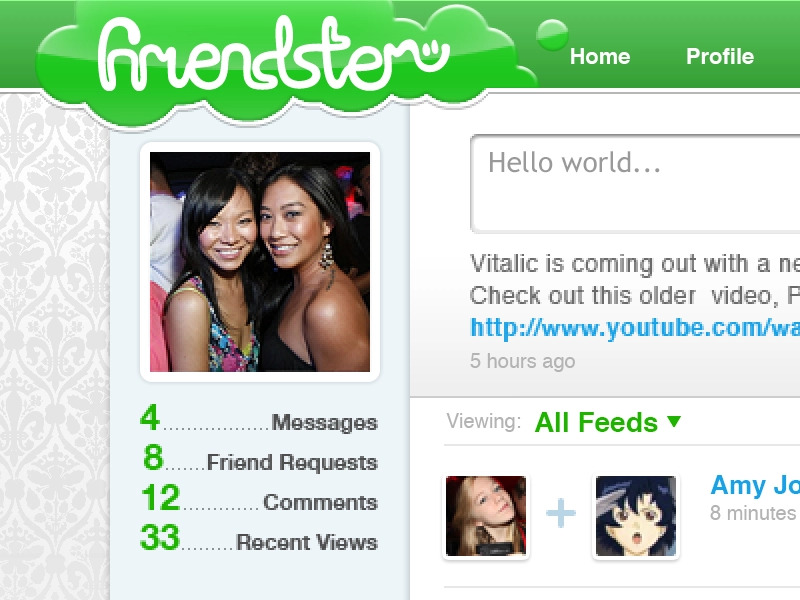
The Rise and Fall of Friendster: A Journey Through the World of Early Social Media
During the nascent stages of social media, predating the emergence of Facebook, Instagram, and Twitter, a trailblazing platform known as Friendster emerged. Friendster played a pivotal role in introducing the concept of online networking and establishing the foundation for the contemporary social media landscape. Although it achieved substantial initial success, Friendster ultimately ceased its operations. In this article, we will delve into the captivating history of Friendster, elucidate the factors contributing to its closure, assess its present-day viability, and provide alternative options for users who yearn for the sentimental appeal of early social media.
History of the Establishment
Friendster was founded in 2002 by Jonathan Abrams, a Canadian computer programmer. The platform was conceived as a way for people to connect with friends and make new connections through mutual acquaintances. At its peak, Friendster boasted millions of users, making it one of the most popular social networking sites of the time.
Friendster’s growth was rapid, and its success drew the attention of major players in the technology industry, including Google. In 2003, Google offered to buy Friendster for $30 million, but the deal fell through, and Friendster continued to operate independently.
Platform Features
The platform’s features included user profiles, photo sharing, testimonials, and the ability to search for and connect with other users. Friendster also introduced the concept of the “Friend of a Friend,” which allowed users to see how they were connected to others within their network, a feature that would later be adopted by other social media platforms like Facebook and LinkedIn.
Impact and Legacy
As the first major social networking site, Friendster played a pivotal role in shaping the online social experience for millions of users. It was a pioneer in its field, setting the stage for the social media revolution that would soon follow.
In 2009, Friendster underwent a major transformation, rebranding itself as a social gaming platform. The site pivoted away from its original social networking focus and aimed to capitalize on the growing popularity of online games. However, this move was not enough to revive the platform, and it eventually shut down its social networking services in 2015.
In 2011, Friendster was acquired by MOL Global, a Malaysian e-commerce company. Although the original social networking site no longer exists, Friendster remains a notable part of Internet history, remembered for its role in pioneering the social media phenomenon and influencing subsequent platforms that followed.
Why it Closed
Despite its initial success, Friendster began to face significant challenges as new competitors entered the market. Some of the key factors contributing to its decline include:
Intense Competition
Facebook, launched in 2004, quickly gained popularity, particularly among college students, while MySpace attracted a younger audience interested in music and pop culture. These platforms offered new features and targeted specific demographics, posing a threat to Friendster’s user base.
Scalability Issues
Friendster struggled to scale its technology infrastructure to accommodate its growing user base. The platform experienced difficulties in handling the increasing demand for bandwidth and server resources, leading to slow page load times and frequent outages. This technical issue frustrated users and drove them to explore alternative platforms.
Lack of User Experience Focus
Friendster failed to evolve and adapt to the changing needs and expectations of its users. While initially innovative in its approach to social networking, the platform’s design and features remained largely unchanged over time. In contrast, competitors like Facebook and MySpace introduced new functionalities and user-friendly interfaces, attracting users seeking a more engaging experience.
Rise of Spam and Fake Profiles
Friendster faced challenges with spam and fake profiles, which negatively impacted the user experience. Users were bombarded with unwanted messages and connection requests, and the platform was slow to address these issues. This further alienated its user base and led to a decline in user satisfaction.
Does it Work Now?
In its original form, Friendster no longer exists. The website, once home to millions of users and their connections, has been taken down, and the company behind the platform has ceased operations.
However, in recent years, there have been attempts to revive the spirit of Friendster through new platforms and initiatives. Some enthusiasts have created Friendster-inspired websites that aim to recreate the early social networking experience for nostalgic users. These sites, though not officially affiliated with the original Friendster, aim to capture the essence of what made the platform unique in its early days.
While these efforts have garnered some interest, they have not reached the same level of popularity or widespread adoption as the original Friendster platform. The social media landscape has evolved significantly since Friendster’s heyday, and the needs and preferences of users have changed accordingly.
Alternatives
For those who are nostalgic for the early days of social media or interested in exploring alternatives to mainstream platforms like Facebook, Twitter, and Instagram, there are several options available:
Ello
Launched in 2014, Ello was initially designed as an ad-free alternative to Facebook. The platform focuses on art, design, and creative expression, providing a space for artists and creators to showcase their work and connect with like-minded individuals.
Diaspora
Diaspora is a decentralized social network that allows users to set up their own servers, or “pods,” to host their content. This gives users greater control over their data and privacy, as they can choose who has access to their information. Diaspora’s interface is similar to that of Facebook or Google+, making it a familiar and user-friendly alternative.
Mastodon
Mastodon is a decentralized, open-source alternative to Twitter. It allows users to post short messages, or “toots,” and follow other users on a platform that is free from advertising and corporate control. Mastodon is made up of multiple interconnected servers, or “instances,” each with its own rules and community guidelines.
Vero
Vero is a social media platform that aims to provide a more authentic and curated experience for its users. The platform emphasizes privacy and control, allowing users to choose who can see their posts and offering an ad-free environment. Vero’s interface is visually appealing, with a focus on high-quality images and content.
MeWe
MeWe is a privacy-focused social network that offers many of the features found on mainstream platforms, including newsfeeds, groups, and private messaging. The platform does not use algorithms to curate content, allowing users to have greater control over what they see in their feeds. MeWe is ad-free and does not sell user data to third parties.
Conclusion
Friendster’s rise and fall serve as a cautionary tale in the ever-evolving world of social media. While the platform was groundbreaking in its time, its failure to adapt and innovate ultimately led to its demise. Today, users seeking an alternative to mainstream platforms can choose from a variety of options that prioritize privacy, user experience, and creative expression. While none of these alternatives has yet achieved the same level of global popularity as the original Friendster, they each offer unique features and experiences that cater to a diverse range of interests and preferences.





